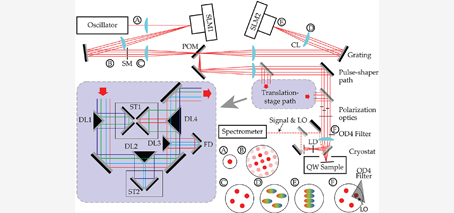Quantifying the dynamics and interactions of electronic systems is crucial for understanding the mechanisms that make them useful candidates for ultra-low energy electronics.
We need to observe and measure the behaviour of electron interactions at a femtosecond scale (ie, at a few millionths of a billionth of a second).
As a research tool, Optical Coherent Multidimensional Spectroscopy (CMDS) offers the ability to study electronic interactions at such timescales within complex systems.
Multiple, high-energy, femtosecond-length laser pulses drive a material into a temporary, excited state, and specific components of the electronic response can then be measured.
CMDS has an advantage over linear spectroscopy in its ability to separate and quantify different types of interactions. Teasing out and quantifying these different contributions is key to describing the function of complex systems.
There are several challenges however to the successful use of CDMS, and a number of solutions have been trialled. A comprehensive Swinburne University of Technology study quantified the advantages and disadvantages of each, particularly their stability and sensitivity with respect to the semiconductor nanostructures and 2D materials key to success at FLEET.
The study also proposed a hybrid method combining the advantages of two methods, which could reveal the complex interactions in the types of materials being developed across FLEET for use in ultra-low energy electronics.
The comprehensive CDMS review, Coherent multi-dimensional spectroscopy: Experimental considerations, direct comparisons and new capabilities by Swinburne University of Technology”s Jonathan Tolleruda and FLEET CI Jeff Davis, was published in ‘Progress in Quantum Electronics’ in July 2017.
In FLEET’s third research theme, light-transformed materials, systems are temporarily driven out of thermal equilibrium to investigate the qualitatively different physics displayed and new capabilities for dynamically controlling their behaviour. Within this research theme, Jeff Davis uses femto-second laser pulses in the ultrafast science facility at Swinburne (established via an ARC LIEF grant) to modify the electronic band structure and create Floquet topological insulators in 2D materials.
The CMDS techniques reviewed will be used to help probe and understand these Floquet topological insulator states.
The facility at the ultrafast science lab to finely control electronic band structure and thereby explore novel topological phenomena also links with FLEET’s first research theme: topological materials.
Want to learn more?
- Contact Prof Jeffrey Davis jdavis@swin.edu.au
- Visit Ultrafast Spectroscopy website
- Follow FLEET on Twitter
- Watch a video on future solutions to computation energy use
- Subscribe to FLEET news

